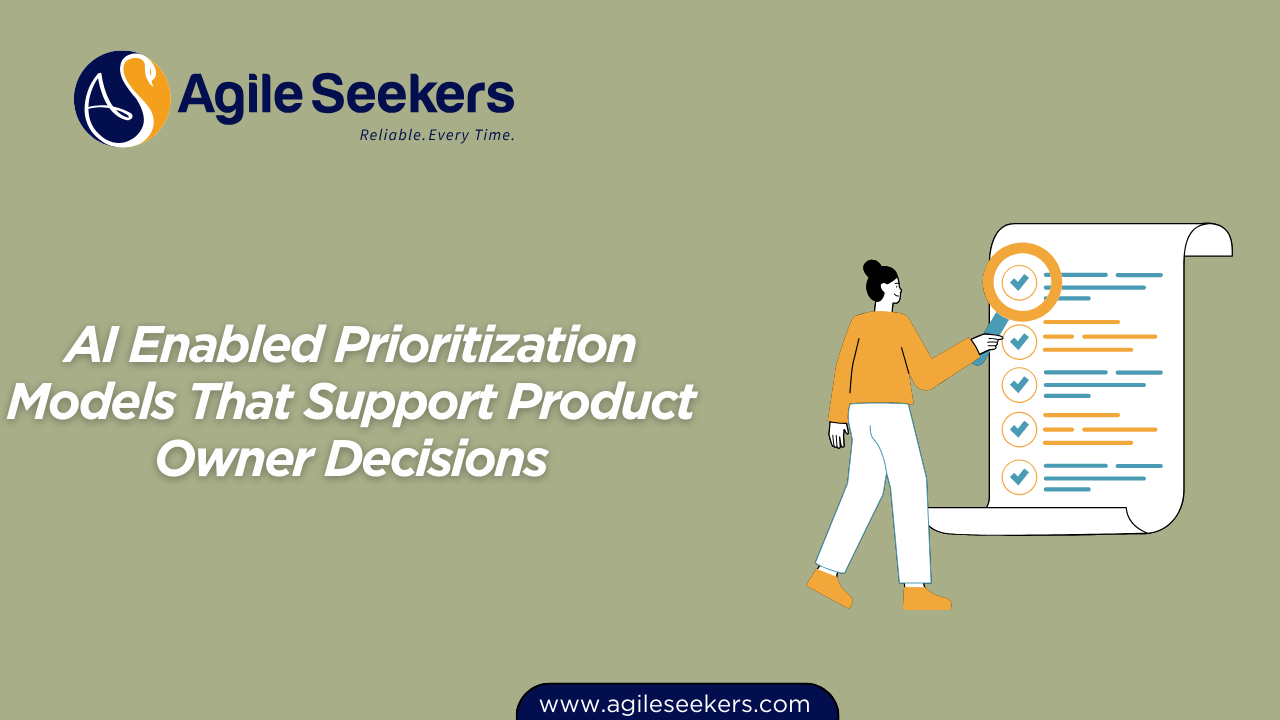AI Enabled Prioritization Models That Support Product Owner Decisions

Product Owners face the constant challenge of deciding what to build next. Every backlog is full of competing demands: customer requests, stakeholder pressure, technical debt, and new opportunities. The real challenge isn’t collecting ideas, it’s deciding which ones will create the most value. This is where AI-enabled prioritization models step in. By combining data-driven insights with human judgment, Product Owners can make smarter, faster, and more defensible decisions.
Why Product Owners Struggle with Prioritization
Backlog prioritization is rarely straightforward. A typical Product Owner must weigh factors like:
-
Customer value vs. effort
-
Strategic alignment vs. quick wins
-
Technical debt vs. new features
-
Short-term revenue vs. long-term growth
Traditional frameworks such as MoSCoW or WSJF (Weighted Shortest Job First) provide structure, but they often depend heavily on subjective scoring. Without reliable data, Product Owners risk bias, misalignment, or simply getting overwhelmed.
How AI Supports Prioritization
AI-enabled models go beyond static scoring frameworks. They pull in live data from multiple sources—user behavior, product analytics, support tickets, competitor trends—and transform them into decision-ready insights. Instead of guessing which item is most valuable, a Product Owner can rely on clear, evidence-backed prioritization.
Here’s how AI makes the difference:
-
Pattern Recognition
AI analyzes historical data to identify which types of features deliver higher ROI, reduce churn, or drive adoption. -
Predictive Value Scoring
Models can forecast the likely business impact of backlog items based on past performance and market trends. -
Effort vs. Benefit Balance
AI can evaluate development effort against potential customer impact, helping prioritize items that maximize return on investment. -
Continuous Recalibration
Unlike static prioritization frameworks, AI models adjust in real-time as new data arrives.
Practical AI-Enabled Prioritization Models
1. AI-Augmented WSJF
WSJF is a popular model in SAFe for balancing value and time. AI strengthens it by providing realistic cost-of-delay values drawn from customer behavior, revenue projections, and user sentiment analysis. Instead of subjective numbers, Product Owners see quantifiable priorities.
2. Customer Sentiment–Driven Prioritization
AI-powered NLP tools scan support tickets, app reviews, and social media to capture customer sentiment. Features that consistently generate negative feedback or high demand can automatically rise in the backlog. This ensures that voice of the customer directly informs prioritization.
3. Predictive Usage Modeling
AI can estimate how often a new feature will actually be used. By analyzing patterns from existing features, the system predicts adoption rates for upcoming items, allowing Product Owners to avoid investing in low-value functionality.
4. Market Trend Alignment
AI engines track competitor releases, industry trends, and emerging technologies. This external perspective helps Product Owners make sure their backlog isn’t just customer-driven, but also market-relevant.
5. Risk-Aware Prioritization
Instead of treating all backlog items equally, AI models highlight those with the greatest risk reduction impact. For example, resolving security vulnerabilities or stabilizing high-failure features might take priority even if they don’t directly generate revenue.
How Product Owners Can Apply These Models
Let’s break it down into practical steps:
-
Centralize Data Sources – Integrate analytics tools, customer feedback, and development metrics into a single platform.
-
Use AI to Surface Insights – Apply machine learning to score backlog items against value, effort, and risk dimensions.
-
Blend Human Judgment with AI Suggestions – AI doesn’t replace Product Owners—it provides evidence they can weigh against context.
-
Revisit Priorities Frequently – Use AI recalibration during sprint planning or quarterly reviews to ensure alignment with shifting business goals.
Benefits for Product Owners
The impact of AI-enabled prioritization models is clear:
-
Less bias, more objectivity: Data-driven scoring reduces politics and gut-based decision-making.
-
Stronger stakeholder alignment: Product Owners can present clear evidence to justify backlog decisions.
-
Faster prioritization cycles: AI shortens the time spent debating priorities.
-
Higher customer satisfaction: Delivering what users truly value leads to stronger adoption and retention.
-
Strategic agility: The backlog stays aligned with market changes, not just internal assumptions.
A Word on Skills
To fully harness AI-enabled prioritization, Product Owners need more than technical tools—they need a growth mindset and strong data literacy. Certifications like AI for Product Owners Certification Training are designed to bridge this gap, helping Product Owners understand how to apply AI insights in real product contexts.
Scrum Masters also play a role in ensuring that teams adapt smoothly to these AI-driven workflows. Courses like the AI for Scrum Masters Training provide practical guidance on supporting teams during this transition.
Agile Leaders and Change Agents also benefit from broader perspectives through programs like AI for Agile Leaders & Change Agents Certification, while Project Managers can explore AI for Project Managers Certification Training to align delivery with value-focused prioritization.
External Inspiration
If you want to see these concepts in action, explore resources like ProductPlan’s guide on prioritization frameworks or Atlassian’s backlog prioritization practices. These examples show how organizations already integrate structured prioritization models with modern tooling.
Closing Thoughts
AI-enabled prioritization models aren’t just another shiny tool. They represent a shift in how Product Owners make decisions—moving from gut feel and politics to evidence-backed, transparent, and dynamic prioritization.
For Product Owners, the real power of AI isn’t about replacing judgment. It’s about augmenting it with insights that ensure every sprint delivers the most meaningful value. Those who embrace these models won’t just manage backlogs better—they’ll become the decision-makers who drive business agility forward.
Also read - How Project Managers Can Use AI To Automate Project Health Checks
Also see - How AI Helps Scrum Masters Foster Psychological Safety In Teams




















